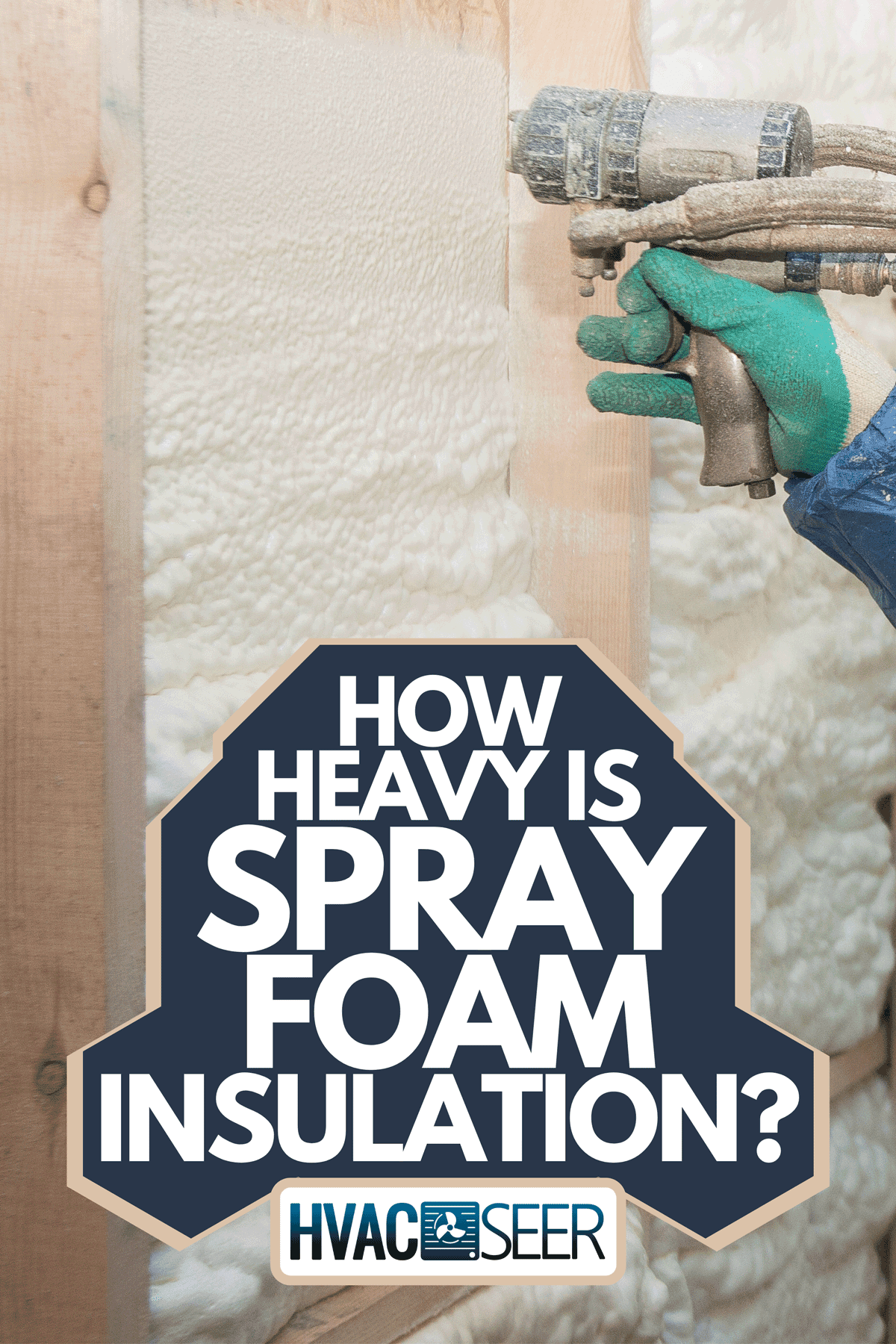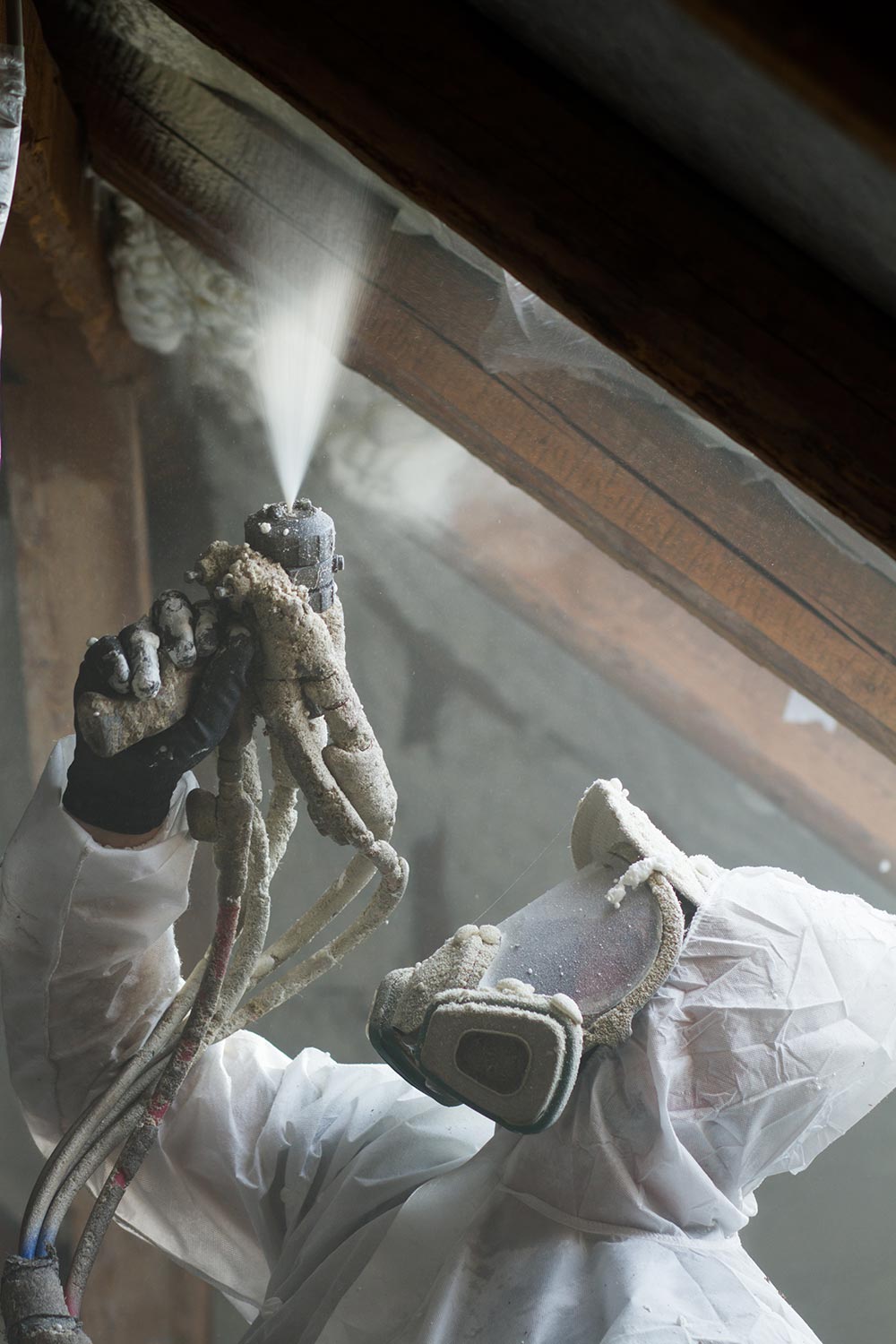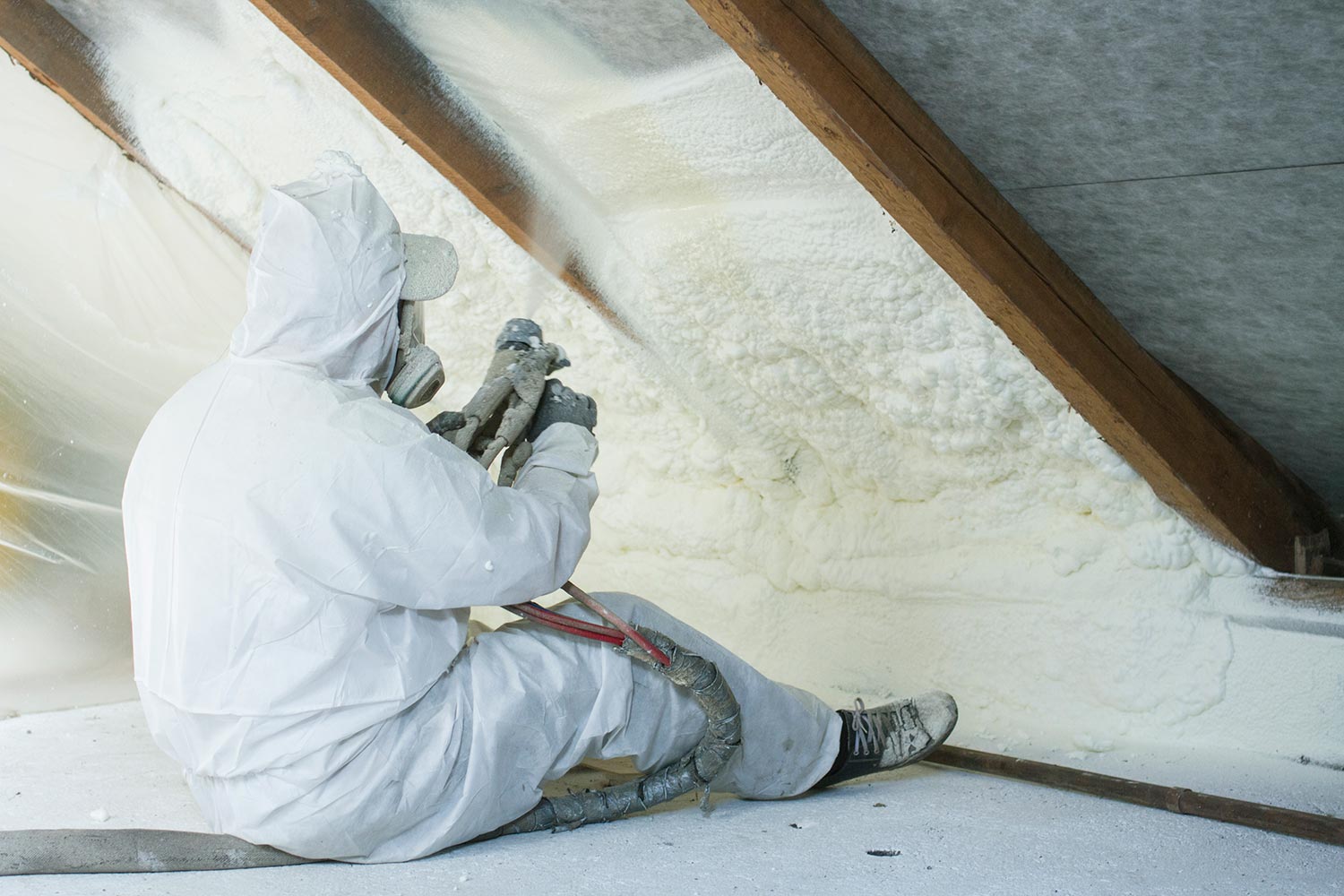Spray foam insulation is used to insulate buildings and seal cracks and gaps. When insulating things, especially roofs, it becomes essential to know how much the insulation weighs so you can ensure it won't weigh too much and damage your project.
Depending on what kind of spray foam insulation you use, it can weigh between 0.4 pounds per cubic foot and 4 pounds per cubic foot when fully cured. There are two kinds of polyurethane spray foam:
- Open cell foam, also known as low-density or 1/2 pound SPF
- Closed cell foam, also referred to as mid-density or 2 pounds SPF
Each of these spray foams has different uses and different weights. This article will discuss each type in detail regarding R-value, how thick it needs to be when applied, and where you shouldn't use spray foam. So be sure to keep reading.

Weight of Spray Foam Insulation
Open Cell Foam
This type of polyurethane spray foam, or SPF, is considered low-density because if you cut the foam into a cubic foot, which is 12 inches by 12 inches by 12 inches, it will weigh about half a pound. This is because the cells in the foam are open, which allows the foam to be very airy and light. As a result, it has a similar texture to a sponge.
Low-density SPF works best for residential jobs, like insulating walls and areas you want to be soundproofed. Open cell foam is not waterproof. Therefore, it is best to use it inside rather than on the exterior of your house.
If you want to make your house more air-tight and energy-efficient, spray foam is a great option! A majority of open-cell foams will be impenetrable by air at least 3.5 inches thick.

Closed Cell Foam
The second kind of spray foam is called closed cell foam, or medium-density foam. It is also available in high-density versions.
Unlike open cell foam, closed cell foam is very rigid and dries into what feels like hard plastic. As the name suggests, the cells that make up closed cell foam are closed. Due to its cell structure, closed cell foam weighs between 2 to 4 pounds per cubic foot. Once it goes over 3 pounds per cubic foot, it is considered high-density foam.
Closed cell foam is best used in commercial jobs, metal buildings, external applications, basements, and crawl spaces. Because of its closed structure, it is good at blocking out moisture and air. It only has to be 1.5 inches to block out moisture and air.
Like open cell foam, it works great to make buildings more energy-efficient. However, it only expands to about 40x its liquid state.
Is 2lb Spray Foam Waterproof?
Yes, 2-pound spray foam is waterproof. Its closed structure blocks out water and is usually not affected by moisture. In addition to being waterproof, it also acts as a barrier for vapor and air. Because of its properties, when used in a basement, it can eliminate the damp smell some basements get when moisture seeps in.
It is so waterproof that it can withstand rains brought by hurricanes and the impacts of strong hail storms. 2-pound spray foam is the way to go if you want to weatherproof your home or if you live in a wet, humid climate.
What Is The R-value?
Before we tell you the R-value of spray foam, let's cover what an R-value is. R-value measures insulation's thermal resistance, or rather how well the insulation resists heat flow. Insulation's R-value will tell you how effective that type of insulation is at keeping your house temperatures stable.
R-value is based on the type of insulation, how thick and dense it is, plus other factors like temperature, aging, and moisture. The Department of Energy has a great article that discusses R-value in more depth.
What Is The R-value Of 2 inches Of Spray Foam?
Now let's get into what the R-value of 2 inches of spray foam is. Open foam's R-value ranges from 3.5 to 3.6 per inch, which means it has an R-value of about R-7. Medium-density foam has an R-value that is almost twice as much as low-density foam. Its R-value is 6 to 8 per inch or 12 to 16 per 2 inches.
Before you start working, make sure to check your foam's R-value because it changes from manufacturer to manufacturer, depending on what material it is made of.
How Thick Does Spray Foam Insulation Need To Be?
The thickness of the foam depends on what type you are using and where you are using it. Open cell foam should be 6 to 10 inches thick when used for a roof or ceiling and 3 inches in walls. When using closed cell foam, it should be 4 to 5 inches thick for ceiling applications and 2 to 3 inches in the walls.
Does More Spray Foam Equal Better Insulation?
So, many people think that the more foam you add, the more effective it is. However, this isn't true. Once the foam is thick enough to create an air-tight seal, adding, more won't be more effective.
A lot of manufacturers list a maximum thickness that keeps their product effective. According to Insulation Institute, this maximum thickness ranges from as low as 2 inches to as high as 6 inches for most types of foam.
Closed cell foam should only be sprayed at about 2 inches thick and then allowed to cure before adding more. This is because the thicker foam will have a harder time curing and can result in unwanted color changes and odors.
Will Spray Foam Support Weight?
The answer to this question depends on which type you are talking about. Open cell foam does not help with structural support or support weight. On the other hand, closed cell foam does.
Medium and high-density foams can be used to strengthen buildings by as much as 300%. They can be walked on and absorb impact from debris that might fall. Using closed cell foam can allow different design options and thinner walls for the same R-value as standard walls.
How To Apply Spray Foam

You can apply spray foam yourself. However, note that it can be messy, and the fumes from the spray can be hazardous. It is incredibly sticky and cannot be removed once applied, so be careful not to get it on clothing, furniture, or anywhere else you don't want it.
If you decide to do it yourself, you will need to wear protective clothing, goggles, protection for your head and feet, gloves, and a respirator. If you have asthma or other health issues, you will want a professional to do it. Keep in mind the drywall will need to be removed before you apply the foam.
There are a couple of ways to apply the foam: with a spray foam gun or a spray foam insulation can. You can get a spray foam insulation kit that will walk you through the steps. If you don't have experience, the can is easier and safer than the gun.
Spray Foam Can
First, put on your protective clothing, including goggles and gloves. Then shake your can for 30 to 60 seconds and put it on the extension tube. Twist it on clockwise, being careful not to break it.
Next, press the tube until the foam comes out and fill the area you are insulating until about half full. It is essential only to fill it halfway because the foam expands.
Once it is cured, trim the excess with a utility knife. Home Repair Tutor has a very informational video about using a spray foam can.
Spray Foam Gun
First, make sure you have your protective equipment on. Then use your manufacturer's directions to put your gun together. After that, make sure your drywall is removed and that the area you're insulating is clean.
After you put your gun together, apply the insulation to the wall. To learn about applying insulation with a gun more in-depth, watch this video by HouseImprovements.
Where Should You Not Use Spray Foam Insulation?
When you are applying spray foam, it is important to know where you shouldn't apply it. Several places can cause a dangerous situation if you apply spray foam to them.
One of these areas is an electrical box. If the foam gets into the box, you can damage it or create a fire hazard. If you do want to insulate your electrical box, use low-expanding foam.
You also do not want to apply it to recessed ceiling canister lights. These lights should only be insulated by a professional so that they don't become a fire hazard.
Another place you do not want to use spray foam is in tight spaces, such as between studs in a wall. To insulate these types of areas, you should use injection foam because it expands slower.
Final Thoughts
We have covered a lot in this article, so here's a quick recap. There are two types of spray foam: open cell and closed cell. Open cell is lighter at half a pound per cubic foot, while closed cell foam is heavier at 2 to 4 pounds per cubic foot.
They differ in many areas, including cell structure, used, and their ability to lock out moisture. If you found this article informative, check out the links below to explore more on this blog:
How Long Does Spray Foam Insulation Smell?
Spray Foam Temperature Settings [Cold And Hot Climate Issues]
